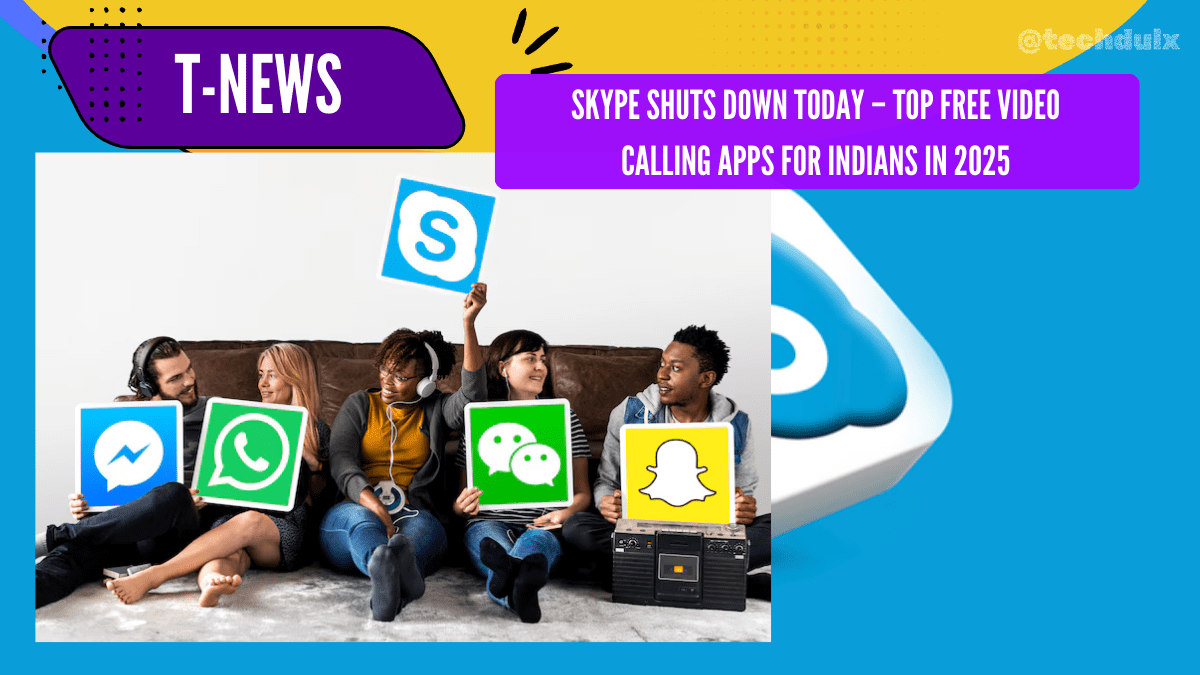The familiar ringtone is silent. On May 5, 2025, Microsoft officially shut down the consumer version of Skype, a platform that, for over two decades, connected millions across India and the globe. While Skype for Business users aren’t immediately affected, regular users now need reliable alternatives.
Microsoft is encouraging everyone to move to Microsoft Teams (Free), offering a smooth transition. But maybe Teams isn’t your cup of tea, or you’re curious about what else is out there.
Don’t worry! India has plenty of excellent, free video calling apps ready to take Skype’s place. Here are the top alternatives you should consider in 2025:
1. Microsoft Teams (Free) – The Official Successor
Microsoft isn’t leaving users stranded. They’ve positioned Teams as the direct replacement for Skype.
- Highlight: Easiest migration path – You can log in using your existing Skype ID, and your contacts and chat history (most of it) will automatically transfer over. You have until January 2026 to log into Teams to retain this history.
- Key Features:
- High-quality video and audio calls (groups up to 100 people for 60 mins on free tier).
- Direct messaging and group chats.
- File sharing capabilities.
- Integration with other Microsoft tools (Calendar, OneDrive).
- Includes many familiar Skype features plus enhanced collaboration tools.
- Why it’s good for India: It’s the official replacement with seamless data transfer. Good for users already in the Microsoft ecosystem.
- Simple Verdict: Best for: Effortless switching from Skype, users needing collaboration features. Downside: Interface might be more complex than simple chat apps for some.
2. WhatsApp – The Everyday Champion
Already installed on nearly every smartphone in India, WhatsApp is the go-to communication app for many.
- Highlight: Ubiquitous and Simple – Chances are, everyone you want to call already uses it. Extremely easy interface.
- Key Features:
- Free voice and video calls (individual and group).
- End-to-end encryption for chats and calls.
- Text messaging, status updates, media sharing.
- Works well even on lower bandwidth connections sometimes.
- Group video calls support a good number of participants.
- Why it’s good for India: Massive user base, simplicity, familiarity, generally data-efficient.
- Simple Verdict: Best for: Personal calls, family groups, quick chats. Downside: Primarily mobile-focused (though web/desktop versions exist), tied to your phone number.
3. Google Meet – Simple & Accessible
Part of the Google ecosystem, Meet offers reliable video conferencing accessible to anyone with a Google account.
- Highlight: No App Needed (Optional) – Users can join meetings directly from a web browser link without installing anything.
- Key Features:
- High-quality video calls (up to 100 participants for 60 minutes on the free plan).
- Screen sharing capabilities.
- Integration with Google Calendar and Gmail.
- Real-time captions.
- Clean, user-friendly interface.
- Why it’s good for India: Most smartphone users have a Google account, browser access is convenient, good integration with other Google services.
- Simple Verdict: Best for: Quick meetings, users heavily reliant on Google services, cross-platform calls (browser access helps). Downside: Free group calls are time-limited (60 mins).
4. Zoom – The Meeting Powerhouse
Zoom became incredibly popular for both business and personal use, known for its stability and features.
- Highlight: Feature-Rich Free Tier – Offers tools like virtual backgrounds, screen sharing, whiteboards, and breakout rooms even on the free plan.
- Key Features:
- Reliable HD video and audio quality.
- Supports up to 100 participants on the free plan (with a time limit, usually 40 minutes for groups).
- Robust meeting controls for hosts.
- Chat functionality during meetings.
- Option to record meetings locally.
- Why it’s good for India: Widely adopted for professional use (interviews, webinars) and reliable for group calls. Good quality performance.
- Simple Verdict: Best for: Larger group calls, online classes, webinars, professional meetings where features matter. Downside: Free group meetings have a stricter time limit (often 40 mins).
5. Telegram / Signal – The Privacy Focused Choices
If privacy and security are your top priorities, these apps offer excellent end-to-end encrypted video calling.
- Highlight: Strong Security Focus – Both platforms emphasize end-to-end encryption for messages and calls.
- Key Features (General):
- Secure 1-on-1 and group video calls.
- Encrypted messaging with features like disappearing messages.
- Less data collection compared to mainstream apps.
- Telegram offers large group chats and channels. Signal is known for its minimalist privacy focus.
- Why it’s good for India: Growing user base concerned about privacy, offers a secure alternative communication channel.
- Simple Verdict: Best for: Users prioritizing security and privacy above all else. Downside: User base might be smaller than WhatsApp; fewer mainstream features compared to Zoom/Teams.
Making Your Choice
- For easiest switch from Skype: Microsoft Teams is the logical first step.
- For personal calls with friends/family: WhatsApp is likely the most convenient.
- For quick meetings without app installs: Google Meet shines.
- For feature-rich meetings/larger groups: Zoom is a strong contender.
- For maximum privacy: Signal or Telegram are your best bets.
Conclusion
While it’s sad to see Skype go, the Indian digital landscape is full of fantastic, free alternatives. Whether you need simple chats, robust meetings, or secure calls, there’s an app ready to keep you connected. Explore these options, see which fits your needs best, and keep the conversations going!
Which Skype alternative are you planning to use or already using in India? Let us know in the comments!
